Abstract
Purpose: For people living with HIV (PLWH) using continuous antiretroviral therapy, HIV is now a complex chronic condition often managed in primary care settings. The patient-centered medical home (PCMH) is a model to deliver comprehensive, coordinated, and integrated primary care that promotes collaboration between primary and specialist care and allied services. The study assessed how both Canadian primary and specialist HIV care settings align with the PCMH.
Methods: Mixed-methods surveys and interviews with providers in Canadian HIV care settings.
Results: Twenty-two settings completed the survey, 12 of which participated in follow-up interviews. Settings had a mean PCMH score of 8.06/12 (SD = 1.53), indicating the basic elements of each PCMH domain have been implemented. We found no significant differences between HIV primary care and specialist care settings. Continuous team-based healing relationships had the highest score (mean = 9.2; SD = 2.15), and quality improvement strategy had the lowest score (mean = 7.19; SD = 2.26). The themes that arose from the interviews were 1) endorsement of the domains of the PCMH by all settings, 2) organizational structures of settings located in hospitals facilitating the implementation of the PCMH through existing technology, patient advisory boards, and accessible services, and 3) dissonance between complex care needs and existing organizational structures in some settings, including limited clinic hours, lack of electronic medical records, and limited mental health services.
Conclusions: HIV care in Canada is reasonably well aligned with the PCMH, irrespective of structure of settings. We propose the need for improvements in the use of electronic medical records, quality improvement strategies, and integration of mental health services to achieve better care delivery and health outcomes among PLWH in Canada.
- AIDS
- Canada
- Chronic Disease
- Delivery of Health Care
- Mental Health Services
- Patient-Centered Care
- Primary Health Care
Due to increased quantity and quality of life arising from combination antiretroviral therapy, HIV has evolved into a complex chronic health condition.1⇓–3 In turn, there is a requirement to shift from a focus on treatment of opportunistic infections toward the prevention and management of multimorbidity4 among people living with HIV (PLWH). This shift reinforces the importance of meeting the comprehensive, continuous care needs of PLWH while promoting the integration of primary care with other medical specialties.5 Physicians specialized in HIV or infectious diseases predominately manage the care of PLWH in Canada,6 and while they are best equipped to deliver disease-specific care,7 primary care providers have the expertise to deliver chronic disease care.8 Canadian HIV primary care settings are more likely to offer preventative health services than specialist care settings.9 Currently, we know little about how the evolving needs of PLWH are met within the settings where they receive care.
The patient-centered medical home (PCMH) is an approach to transforming primary care delivery through improving its quality, effectiveness, and efficiency, thereby facilitating its role as the foundation of a high-performing health system.10 The joint domains of the PCMH (Table 1) have the potential to address existing care gaps through integration and collaboration between primary and specialist care, community health and social services.11 The Ryan White–funded HIV clinics became early adopters of the PCMH model12 that has since become the standard for primary care delivery.13⇓–15 A recent study of HIV clinics within the Veterans Affairs Health System found variation in the alignment of HIV specialty clinics to PCMH principles.16 Our objective was to determine the alignment of Canadian HIV care settings, which vary considerably in structure, function, and team composition,9 to the PCMH. As all Canadian provinces have a single-payer system with universal access to physician services, our findings can inform recommendations to ensure PLWH receive patient-centered care in a setting and with providers appropriate to their evolving physical, mental, cognitive, and social needs.
Domains of the PCMH Framework
Methods
Study Design
We conducted an explanatory sequential mixed-methods study, which included a Web-based survey between June 2015 and January 2016 followed by semistructured interviews between November 2016 and February 2017. The survey was used to evaluate the alignment of HIV care settings with the PCMH, while the interviews with a sample of the survey respondents were conducted to further explain the results from the survey and to assess in greater detail if and how settings implement the joint domains of patient oriented care as specified by the PCMH.
Setting and Participants
The study is part of a large Canadian Institutes of Health Research funded team grant (https://www.lhiv.ca/). Appendix A outlines our sampling strategy. We identified Canadian HIV care settings using purposive sampling of potential settings based on an environmental scan and expert knowledge of team members. We recruited key contact persons at these settings via phone and invited them to participate. We included settings with an identified focus on providing care to PLWH, but did not restrict our search based on proportion of patients with HIV or on whether services were provided to an HIV priority population, such as men who have sex with men. Survey participants were asked for consent to be contacted for a follow-up interview. Interview participants received a $75 gift card.
Theoretical Framework
Our research was guided by the PCMH framework including 8 evidence-based domains that were specifically developed to guide settings that intend to become a PCMH17 (Table 1). The domains define the characteristics and behaviors that constitute a PCMH, enabling our team to assess the individual setting's level of alignment with each of the 8 domains.
Measurements
We developed the Canadian HIV Clinic Survey, which included an adaptation of 2 validated primary health care surveys, the Patient-Centered Medical Home Assessment (PCMH-A)10,13 and the Canadian Institutes of Health Information Organizational Attributes of Primary Health Care Survey.18 The PCMH-A tool was developed for care settings to assess their alignment to the PCMH model.19 Each domain is scored on a 12-point scale, with total scores associated with a level and corresponding interpretation (Table 2).We modified the PCMH to ensure relevance to the Canadian health care system while leaving the scoring system unchanged.
Interpretation of PCMH-A Scores
After survey analysis, the team reviewed the data and developed an interview guide to further assess the implementation of the patient-oriented aspects of the PCMH. Two interviewers conducted semistructured interviews over the phone with physicians, nurses, and others in leadership positions at 12 of the 22 surveyed settings. Interviews included questions about the services offered, the setting's approach to patient-centered care, and the involvement of senior management. Interviews were recorded and transcribed verbatim.
Analysis
To analyze the survey responses, we categorized settings into 2 groups: clinics containing either a family practitioner or a nurse practitioner (primary care settings, n = 12) and settings containing only an infectious diseases specialist (specialist care settings, n = 10). We calculated the mean and standard deviation to assess settings' PCMH scores and used 2-tailed independent samples t-tests to assess differences in scores between the groups.
Interviews were analyzed by 2 reviewers using the coding framework approach for qualitative data analysis.20 The goal of the analysis was to assess how settings interpreted the patient oriented aspect of the PCMH and how settings perceived their care practices to align with the PCMH. A thematic framework was constructed based on the definitions of the 8 domains of the PCMH, and in direct correspondence with the survey. The data were coded to identify elements confirming and disconfirming alignment with the PCMH, to compare the answers of providers from primary care and specialist care settings, and to compare between settings with lower and higher PCMH alignment. The reviewers met weekly to compare and discuss their findings, which were shared with collaborators, including 3 PLWH, who helped interpret the results and to derive at the themes that helped contextualize the quantitative survey results. In addition, as with all studies on our team,21 PLWH collaborators participated in the development of the research questions, the initial design of the research and the creation of the interview guide. They were consulted about the relevance of the research findings to the lives of PLWH. They, for example, highlighted the role of technology and the associated advantages and disadvantaged of a functioning EMR system. NVivo 11 was used for analysis.22 The ethics boards of the Ottawa Health Sciences Network (protocol #20140649 a - 01H) and Bruyère Continuing Care (protocol #M16 a - 15 a - 011) approved the study.
Role of the Funding Source
The study was funded by the Canadian Institutes of Health Research (CIHR) FRN TT5 a - 128270. CIHR had no role in the design of the study, the collection, analysis, and interpretation of the data, and the reporting of the findings.
Results
Background Information of Participating HIV Care Settings
Twenty-two care settings completed the survey (response rate of 51%): 20 in English, 2 in French. Sixteen of the 22 surveyed settings (73%) consented to be contacted for follow-up interviews, and 12 of the 16 (75%) were interviewed. The details of the organizational attributes of the settings are provided elsewhere.9 Most Canadian HIV care settings were located in urban settings (19/22 in a city) and 15/22 care settings were located within a hospital. Twelve settings were defined as primary care and 10 as specialist care settings.
Alignment with the PCMH
The mean PCMH-A score of the settings surveyed was 8.06 (SD = 1.53) out of a possible 12 points, indicating that the “basic elements” of each domain have been implemented. There were no significant differences between primary care and specialist care settings across either mean or individual PCMH domain scores (Table 3). Two settings scored in level A, representing higher alignment with the PCMH and providing patient-centered care, and 5 settings scored in level C, representing lower alignment with the PCMH and offering only basic support for patient-centered care. There were no significant differences in mean PCMH total score and individual domain scores between survey respondents who did and did not consent to be interviewed.
PCMH-A Scores of Primary and Specialist Canadian HIV Care Settings by Type of Care Settings and Interpretation
Rostering
Rostering refers to the assignment of individual patients to specific providers and forms the basis for continuity of care and population health management. The mean score for patient rostering was 8.23 (SD = 2.31) reflecting that most patients are registered with a particular provider but that improvements can be made by using electronic medical records (EMRs) to support care. Most (10/12) interview participants described that patients are assigned to a specific provider, “so the patient will always know who their nurse is or who to contact if they have issues” (setting (S) 7). In contrast, 2 participants explained that the care of all their patients is shared between providers. Although participants recognized their importance, the availability and uptake of EMR as a tool for rostering and population planning was limited, “[The EMR is] not great in terms of us being able to track CD4 or viral loads” (S9). Participants without EMR (4/12) expressed frustration about not having access to these data, and 1 explained that concern for privacy breaches inhibited them from making patient data accessible electronically.
Continuous, Team-Based Healing Relationships
Continuous, team-based healing relationships includes encouraging patients to see their own provider, nonphysician providers being able to perform important clinical roles, and the provision of training as required by staff. It was the highest-scoring domain with a mean of 9.2 (SD = 2.15) illustrating that the continuous care approach is well integrated in Canadian HIV care settings. Interview participants described working as large and well-integrated teams where patients were oriented to all team members: “They are always introduced to our social workers, even if they do not need anything at that time. At least they have a name and a face and a card so if there are issues down the road. And then introduce them to any other team members that they might need” (S1). In contrast, 1 setting with lower PCMH alignment explained that their team only consists of infectious disease specialists.
An important premise of a PCMH is that team members work to their full scope of practice.24 One participant described ensuring their staff received training that enabled them to care for complex clients, “A lot of our staff are trained in motivational interviewing and […] have those skill sets to move people or start to engage people in terms of health goals” (S9). While scores were high across settings, we identified limitations in the implementation of this domain. For example, the roles of individual clinicians within settings were not always clearly delineated, “Sometimes I am the social worker even though I am not trained. Sometimes the social worker is the nurse practitioner a little bit” (S4). In addition, some settings reported that continuous care is compromised due to high staff turnover.
Patient-Centered Interactions
The domain patient-centered interactions include a systematic assessment of patient's values and preferences, encouragement of and support for shared decision making and the provision of self-management support services. Settings had a patient-centered interactions score of 7.89 (SD = 2.18) showing that settings generally respected patients' values, supported shared decision making and elicited patients' feedback. Interview participants were able to define the concept well even in instances where they reported struggling to implement such care in practice. One participant from a setting with lower PCMH alignment described a patient-centered setting as “a clinic that offers care to clients who have, with HIV. It is a clinic that can respond to needs, say, from Monday to Friday with a sort of walk-in approach where patients can be seen, can get information. In addition, it is a place where patients can be followed by a multidisciplinary team that can include at times a doctor, a nurse, a pharmacist, a social worker precisely to organize many, many different orientations of this, treatment of this clientele, which goes way beyond HIV, of course. It can be work-related problems, insurance, health insurance, employment, other conditions, other associated comorbidities” (S12). However, they then reported, “For us, our clinic is not such a clinic.” Some participants explained that limited consultation time inhibits a patient-centered approach, while others said their staff may not be sufficiently trained to provide patient-centered care.
All participants described the importance of patient-centered care, “When we first meet with the family and patient we describe to them what our clinic, how our clinic functions […], help them be part of the decision making of when starting medication or we need to know more about the family dynamics and if there's issues that would be roadblocks to treatment. So I think it is always approaching the family as they are part of the team” (S8). Multiple settings (5/12) facilitated patient-centeredness using translation services, including access to American Sign Language.
All settings elicited patient feedback through surveys and 3 settings involved community members as representatives on patient advisory boards, a system that had been implemented at their affiliated hospital. Participants from settings with lower PCMH alignment were concerned about the limited input patients have regarding organizational decisions, “In terms of leadership and decision making, we need more patient input as well” (S10).
Engaged Leadership
Engaged leadership incorporates supportive executive and clinical leaders who support the implementation of PCMH principles. Settings had a mean engaged leadership score of 8.10 (SD = 2.30), indicating generally a shared vision of staff and management for the PCMH model of care and their systematic collaboration to provide best care for patients. Many participants (7/12) described working in a supportive environment where management understands the principles of patient-centered care and leaders are engaged and listen to needs of front-line staff. One setting with higher PCMH alignment explained that, as a community health center, the tenets of patient-centered care were embedded in their operations. Five settings (4 of which had lower PCMH alignment) described their leaders as disengaged, related to the care setting being located within a larger hospital, “It is a big hospital so, the big changes we do not find out about, […] they are made outside of our realm” (S1). Participants reported that hospital leadership may not fully understand the complexities of HIV care when making budget or staff decisions, thus risked implementing changes without adequate consultation.
Quality Improvement Strategy
This domain refers to the implementation and measurement of activities that are meant to improve care quality and patients' experiences and health information technology is an important component. Quality improvement strategy had the lowest mean score of 7.19 (SD = 2.26) and the 5 settings with lower PCMH alignment had particularly low scores (range, 3.67 to 5.5) in this domain, reflecting that settings initiated quality improvement activities, but they often did not measure the outcomes of such activities. Settings with higher PCMH alignment described using surveys to collect data on patients' experiences, “We survey every year to make sure that we are meeting the needs of our patients and our clients. [… ] And we try to make changes accordingly whenever we possibly can” (S1), but they did not describe how the findings were used to implement organizational change. Another participant shared that their setting routinely assesses its policies and procedures using an externally administered survey. However, as described, uptake of EMR for quality improvement was limited in most settings.
Enhanced Access
Enhanced access corresponds to the elimination of barriers for patients to access care, including time, place, and cost of care. Settings had a mean enhanced access score of 7.39 (SD = 2.45), reflecting a perceived ability to provide patients with flexible and affordable access to care, services, and advice around the clock. Six settings had limited times for patient visits because their services were bound by hospital hours. One of those settings, with higher PCMH alignment, compensated by providing telephone access between in-person appointments, “We have business cards that we give them if there's any issues or side effects that they experience” (S1). To enhance geographic reach, videoconferencing access was offered at 2 settings, and 2 other settings provided patients with flexible hours including evening and weekend, “because we all share the same electronic medical record, if let us say a person with HIV ran out of their antiretrovirals and it is Sunday, from noon to 4 they could go to 1 of our 6 sites” (S4). Participants from all settings described having pharmacists or social workers with the expertise to help patients navigate the various potential funding schemes for affordable HIV medication access.
Care Coordination
Care coordination refers to the appropriate allocation of care services within settings and communities. Settings had a mean care coordination score of 8.37 (SD = 1.69), indicating patient care is organized reasonably effectively. Interview participants explained in great detail the relationships they have fostered among providers within their settings and communities to care for their patients' complex needs. Eleven settings coordinated extensive services beyond HIV-specific care. Participants from several settings outlined the need for their patients to have a primary care provider who will coordinate the person's care, “We are specialists. […] We're seeing the patient, we're following the patient for the HIV. But we depend on the primary care doctors to follow on a regular basis” (S6). A participants from a setting with lower PCMH alignment described visit length being too short for specialists to properly manage all the needs of their patients. To greater meet their patients' needs, this setting employed a social worker and a case manager to coordinate required care and social services for their patients within the community, while other settings employed “nurse practitioners who provide primary care services” (S9). All interview participants described a need for more mental health services, including trauma and addiction services, which were either not available or not available in a timely fashion for all patients either in the care setting or the community. Finally, use of an EMR was described as being important for intraclinic communication and collaboration around individual patients, “Our director of the HIV program also has access to our EMR so that we can consult him through the EMR and he'll respond with, to do a chart review. And give us that expert advice” (S3).
Organized, Evidence-Based Care
Organized, evidence-based care includes the use of guideline-based information when making care decisions to meet patients' acute, preventative, and chronic care needs and to ensure follow-up care. Settings had a mean of 8.09 (SD = 2.19) in this domain, reflecting care is generally structured to meet both urgent and preventative needs and high-risk patients are identified; however, settings' scores varied considerably. Several participants described using practice data to address the complex needs of their patients. A participant from a setting with higher PCMH alignment spoke about the role of case managers, who they involved in the development of care plans, “provincially, there's been a lot of success around case management and a lot of our patients simply would not be engaged in care if they did not have case management” (S10). One participant described using the data collected with the EMR effectively to apply evidence-based strategies to care for their patients, “We stratify then by CD4 counts. So we can sort of prioritize those patients who are at highest risk of getting sick” (S3). Based on the EMR reports, the nurse and physician will collaborate with social workers to create care plans.
Discussion
Our analysis has 3 important findings that advance our understanding of the alignment of Canadian HIV care settings with the PCMH. First, all HIV care settings interviewed endorse the domains of PCMH, irrespective of their composition. While a study in the US found that traditional specialist consultation models struggled to implement the principles of the PCMH,16 we found no differences between specialty and primary HIV care settings in their alignment to the PCMH model. At the start of the epidemic, HIV care was interdisciplinary out of necessity, with specialists collaborating with primary care and other providers to improve patients' quality of life.5,24 This grassroots collaboration could explain the similarities we found between primary and specialist care settings and the recognition among interviewed participants from specialist settings of the importance of connecting their patients to primary care. While the PCMH was envisioned for primary care transformation, there is recognition for the need of implementing PCMH domains in specialist care settings and Infectious disease participants understood the need for patient-centered HIV care. Fix et al16 noted that a specialist consultative model poses a risk to PCMH-principled care and our research shows that they can align well with the PCMH when collaborating and communicating closely with primary care by establishing relationships with primary care settings. In addition, all settings strongly endorsed team-based care and interdisciplinary collaboration, consistent with care models for people with other chronic conditions.25 Few settings delivered complete enhanced access to care, but settings mitigated this by offering after-hour telephone services, telemedicine and by connecting patients to primary care physicians. Settings also ensured their patients have access to affordable medications, which remains a gap for PLWH in Canada despite our universal access to physician services.26 In addition, all participants reported on the importance of incorporating the patient perspective into how care is delivered within their settings.27
Second, our results reflect that existing organizational structures of care settings located in larger institutions can help facilitate the implementation of PCMH domains. Despite structural variation, overall, settings leveraged existing resources such as established patient advisory boards, EMR and technology,15 including telemedicine and translation services. Larger organizations are further more likely to have established protocols for care coordination,15 which was noted by participants to be required to address the clinical complexity of HIV care.
Third, we found that some settings experienced dissonance between the complex needs of their patients and existing organizational structures and rigid organizational policies. Even though a number of settings had EMR, some struggled with using EMR to fulfill PCMH domains. For example, participants expressed challenges in using the EMR as a clinical information system for population management, to implement decision support, or to facilitate communicate with other providers. The inhibited use of EMR due to rigid policies limited the ability of setting to measure and achieving cascade goals, and modification to existing EMR systems may be needed to fully meet the needs of the population.28 In addition, limited clinic hours were described as a barrier for care access, despite after-hours access being increasingly recognized as important for high-quality care.29 The lack of mental health services within settings was particularly daunting for participants. There is a high burden of mental health and addiction for PLWH30 and increasingly large wait times for mental health services were noted in the interviews. While not specifically prompted, none of the participants described comprehensive quality improvement strategies, despite the increasing emphasis on quality improvement in health systems practices.31,32
We acknowledge limitations in our study. Settings in some provinces did not participate, limiting the generalizability of our findings. The participating settings were predominately in urban areas, potential due to challenges in access to specialty care services in rural areas,33 where sites may not promote themselves as HIV care settings. Our data are based on self report, thus response bias is anticipated. While the PCMH can serve as a framework to assess change in the quality of care over time, we intentionally adopted it as a theoretical framework to highlights how settings align with the PCMH and where there is a need for improvement at 1 point in time. Finally, while we include people with lived experience as coauthors on this project, PCMH scores and interviews were obtained from care teams, which may not reflect the patient experience of care.
In conclusion, Canadian HIV care settings were highly committed to the domains of patient-centered care, but implementation of the PCMH was at times limited by organizational structures and processes. Lessons learned from our analysis are the need for improvements in the use of technology to improve population management and quality improvement strategies, as well as accessible mental health services to achieve better care delivery and health outcomes among PLWH.
Acknowledgments
We thank the participants who generously donated their time and filled out the survey and answered our interview questions. We are grateful to Naomi Tschirhart and Danielle Rolfe who conducted the interviews.
Appendix A

Appendix B









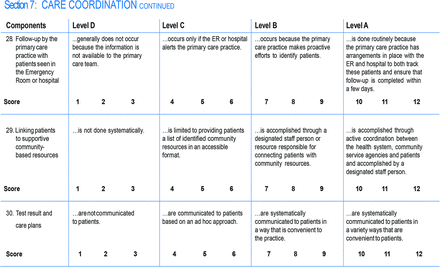
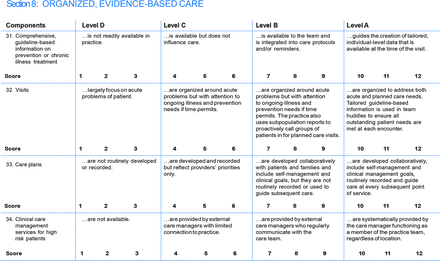
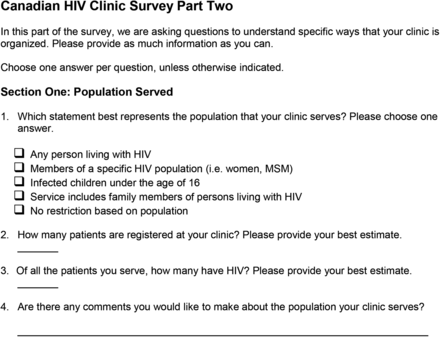
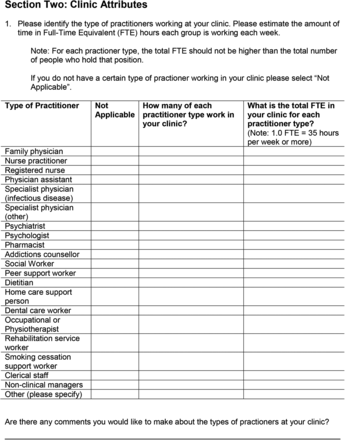
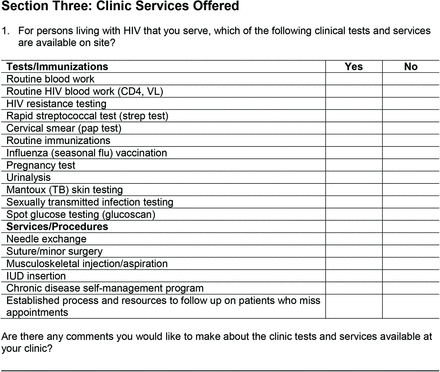
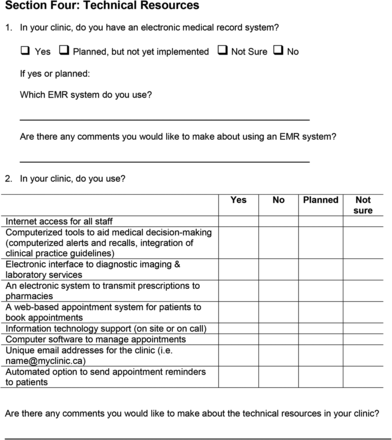


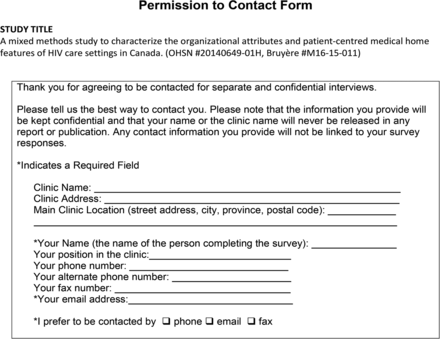
Appendix C
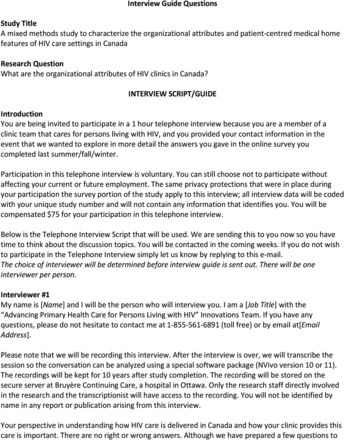
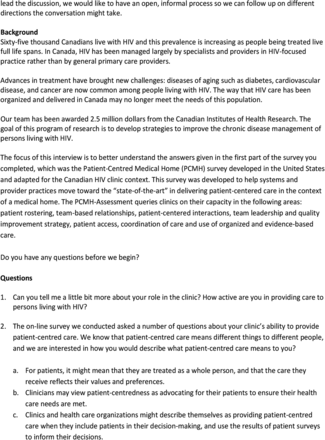
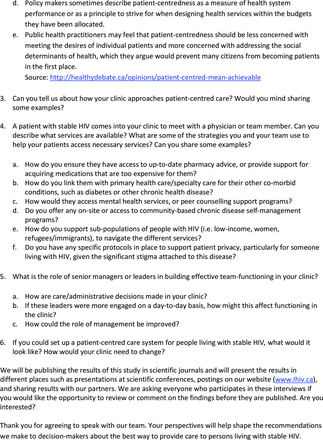
Notes
This article was externally peer reviewed.
Funding: The study was funded by the Canadian Institutes of Health Research (CIHR) FRN TT5-128270.
Conflict of interest: none declared.
Disclaimer: The authors are solely responsible for the content of the article.
To see this article online, please go to: http://jabfm.org/content/32/2/158.full.
- Received for publication August 9, 2018.
- Revision received November 2, 2018.
- Accepted for publication November 5, 2018.






